标签:number his nim strong pwd emma list() transient art
一:Java简介
Java语言的介绍:Java是一门面向对象编程语言,不仅吸收了C++语言的各种优点,还摒弃了C++里难以理解的多继承、指针等概念,因此Java语言具有功能强大和简单易用两个特征。
Java语言的特点:简单性、面向对象、分布式、健壮性、安全性、平台独立与可移植性、多线程、动态性等
Java语言的应用:编写桌面应用程序、Web应用程序、分布式系统和嵌入式系统应用程序等
二:Java自学路线图
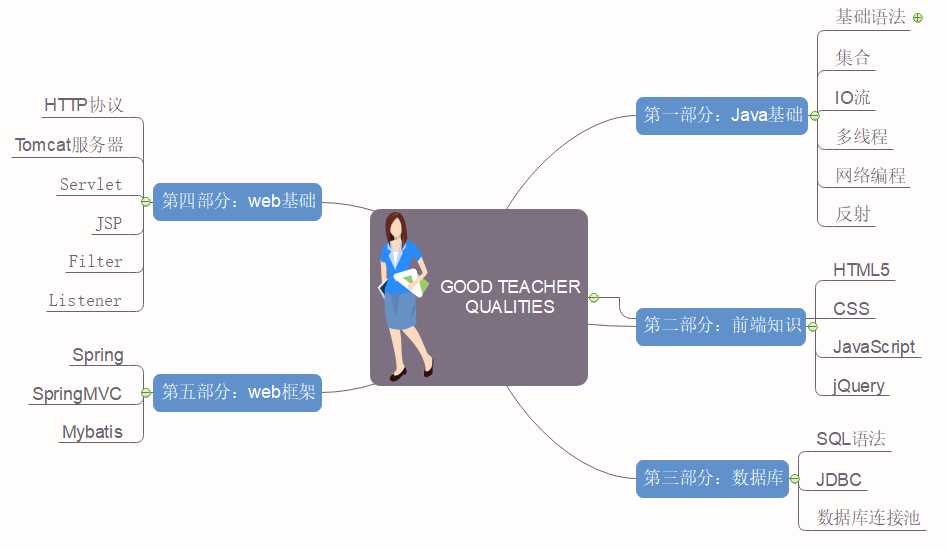
三:Java基础
一、标识符和关键字
二、数据类型
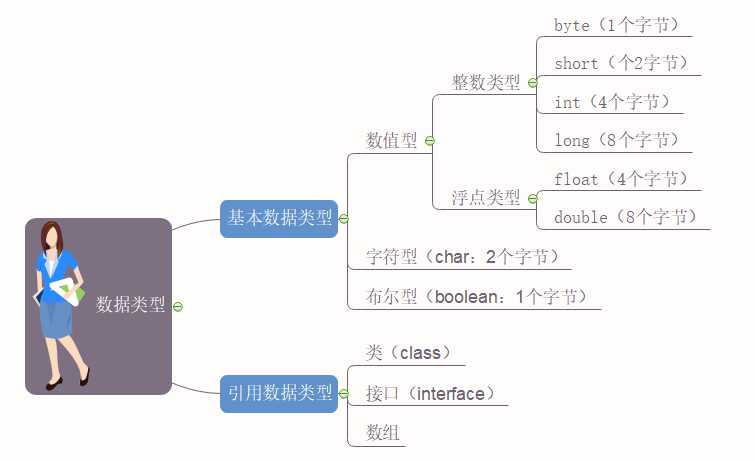
三、运算符与表达式
1. 算数运算符:加(+),减(-),乘(*),除(/),求余(%)
2. 赋值运算符:=,+=,-=,*=,%=
3. 关系运算符:>,<,>=,<=,==,!=
4. 逻辑运算符:[&&,||](只有左侧满足才计算右侧),!,[&,|](不管左侧结果如何,都要计算右侧)
5. 三目运算符:(表达式) ? 值1,值2;
四:流程控制语句
1. 条件分支语句:if语句,switch语句
2. 循环语句:while循环,do while循环,for循环,foreach循环
四:数组
1. 声明数组:
1. 静态初始化: 数据类型 [ ]... 数组名 = {值1,值2,...}
2. 动态初始化:数据类型 [ ]... 数组名 = new 数据类型[长度];
2. 打印数组:foreach循环
3. 数组排序:冒泡排序,选择排序,反转排序,插入排序
4. Arrays工具类:
1. 排序
1. 实现Comparable接口:Arrays.sort(要排序的数组)
2. 实现Comparator接口:Arrays.sort(要排序的数组,new Comparator);
2. 二分法查找:binarySearch(要查找的数组,要查找的值),必须提前拍好序
3. 数组元素比较:Arrays.equals(数组1,数组2)
4. 数组填充:Arrays.fill(要填充的数组,值)

import java.util.Arrays; public class TestArray { public static void main(String[] args) { // 数组的静态初始化 int[] array1 = { 1, 3, 5, 6, 7, 2, 4, 10 }; // 数组的动态初始化 int[] array2 = new int[5]; array2[0] = 1; array2[1] = 2; array2[2] = 7; array2[3] = 3; array2[4] = 4; // for循环打印数组 for (int i = 0; i < array2.length; i++) { System.out.print (array2[i]); } // foreach打印数组 for (int i : array2) { System.out.print(i); } // 排序 Arrays.sort(array2); for (int i : array2) { System.out.print(i); } // 二分法查找 System.out.print(Arrays.binarySearch(array2, 3)); // 数组元素比较 System.out.println(Arrays.equals(array1, array2)); // 数组元素填充 Arrays.fill(array2, 1); for (int j : array2) { System.out.println(j); } } }
五:面向对象
一、封装
1. 核心思想:隐藏细节,保护数据安全。
2. 访问权限
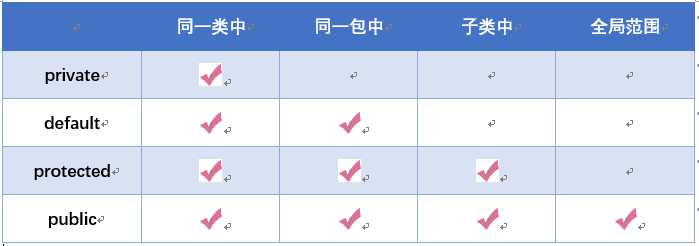

public class Encapsulation { // 1.成员属性私有化 private String name; private String pwd; // 2.提供getter和setter方法来访问 public String getName() { return name; } public void setName(String name) { this.name = name; } public String getPwd() { return pwd; } public void setPwd(String pwd) { this.pwd = pwd; } } class TestEncapsulation { public static void main(String[] args) { Encapsulation test = new Encapsulation(); // 3.通过setter方法设置属性值 test.setName("封装"); test.setPwd("666"); // 4.通过getter方法获取值 System.out.println("姓名:" + test.getName() + " -- 密码:" + test.getPwd()); } }
二、方法的重载和重写
1. 方法的重载:方法名相同,参数列表不同
2. 方法的重写:方法名、返回值类型、参数列表都相同,构造方法和使用final、static修饰的方法不能被重写
三、继承
1. 核心思想:解决代码冗余,提高代码的复用性
2. 继承关系:满足is-a的关系,父类更通用,子类更具体。

/** * 1. 将类中重复的部分提取成为父类 */ public class Animal { private String name; private String food; public Animal(String name, String food) { this.name = name; this.food = food; } public void eat() { System.out.println(name + "正在吃" + food); } } /** * 2. 子类继承父类,对父类进行扩展 */ public class Cat extends Animal { public Cat(String name, String food) { super(name, food); } } public class Dog extends Animal{ public Dog(String name, String food) { super(name, food); } } /** * 3. 测试 */ public class TestExtends{ public static void main(String[] args) { Animal cat = new Cat("三三", "鱼"); cat.eat(); Animal dog = new Dog("二哈", "香肠"); cat.eat(); } }
四、多态
1. 核心思想:提高代码可维护性和可扩展性
2. 实现多态的三个必要条件:继承、重写、父类引用指向子类对象(向下转型)
3. 多态的实现方式:重写、接口、抽象类和抽象方法

/** * 1. 创建动物类,定义动物吃什么的方法 */ class Animals { private String name; private String food; public Animals(String name, String food) { super(); this.name = name; this.food = food; } public void eat() { System.out.println(this.name + "会吃" + this.food); } } /** * 2. 创建Cat类来实现吃的功能 */ class Cat extends Animals{ public Cat(String name, String food) { super(name, food); } @Override public void eat() { super.eat(); } } /** * 3. 通过向上转型和向下转型实现多态 */ public class Test01 { public static void main(String[] args) { // 向下转型 Animals animals = new Cat("三三", "鱼"); animals.eat(); // 向上转型 Cat cat = (Cat) animals; cat.eat(); } }
五、抽象类
1. 核心思想:让代码有更强的可扩展性
2. 特点:
1. 抽象类不能实例化对象。
2. 如果一个类包含抽象方法,那么该类必须是抽象类。
3. 任何子类必须重写父类的抽象方法(具体实现),或者声明自身为抽象类。
4. 抽象类中的抽象方法只有方法声明,没有方法体
5. 构造方法和static修饰的方法不能声明为抽象方法

/** * 1. 创建员工抽象类 */ abstract class Employees { // 成员变量 private String name; private String address; private Integer number; // 构造方法 public Employees(String name, String address, Integer number) { System.out.println("Employees.Employees()"); this.name = name; this.address = address; this.number = number; } // 定义信息抽象函数 public abstract void call(); public String getName() { return name; } public void setName(String name) { this.name = name; } public String getAddress() { return address; } public void setAddress(String address) { this.address = address; } public Integer getNumber() { return number; } public void setNumber(Integer number) { this.number = number; } } class Salary extends Employees { private Double salary; public Salary(String name, String address, Integer number, Double salary) { super(name, address, number); this.salary = salary; System.out.println("Salary.Salary()"); } // 2. 重写父类的抽象方法 @Override public void call() { System.out.println(super.getNumber() + "是" + super.getName() + "的电话,他住在" + super.getAddress() + "他现在的工资是" + this.salary); } } public class Test { public static void main(String[] args) { // 3. 抽象类的对象必须由子类去实例化 Employees emp = new Salary("孙悟空", "花果山", 1234, 222.66); emp.call(); } }
六、接口
1. 核心思想:让代码有更强的可扩展性
2. 特点:
1. 接口不能实例化对象,没有构造方法
2. 接口中的方法只能是抽象方法,默认使用public abstract修饰
3. 接口中的变量只能是常量,默认使用public static final修饰
4. 接口支持多继承,但接口不是被继承了,而是被实现了
3. 接口和抽象类的区别
1. 接口中的方法只能是抽象方法,而抽象类中的方法可以是普通方法,构造方法和抽象方法
2. 接口中的变量只能是常量,而抽象类中的方法可以是任意类型
3. 接口中不能含有静态代码块和静态方法,而抽象类中可以有
4. 一个类可以实现多个接口,但一个类只能继承一个抽象类

/** * 1. 创建Animal接口 */ interface Animal { // 定义睡觉抽象方法 void sleep(); // 定义吃饭抽象方法 void eat(); } /** * 2. 创建Dog接口继承Animal接口 */ interface Dog extends Animal { // 定义游泳抽象方法 void swim(); } /** * 3. 创建HaShiQi接口继承Dog和Animal接口,实现多继承 */ interface HaShiQi extends Dog, Animal { // 定义拆家抽象方法 void demolishedFamily(); } /** * 4. 创建测试类来实现接口,并且复写所有抽象方法 */ public class TestAnimal implements HaShiQi { @Override public void swim() { System.out.println("哈士奇会游泳"); } @Override public void sleep() { System.out.println("哈士奇会睡觉"); } @Override public void eat() { System.out.println("哈士奇喜欢吃苦瓜"); } @Override public void demolishedFamily() { System.out.println("哈士奇会拆家"); } public static void main(String[] args) { // 使用多态实例化对象 HaShiQi dog = new TestAnimal(); dog.eat(); dog.sleep(); dog.demolishedFamily(); dog.swim(); } }
六:集合
一、集合简介
集合的主要作用是存储引用类型数据,长度可以动态的改变,解决了存储数据数量不确定的问题
二、Collection集合体系
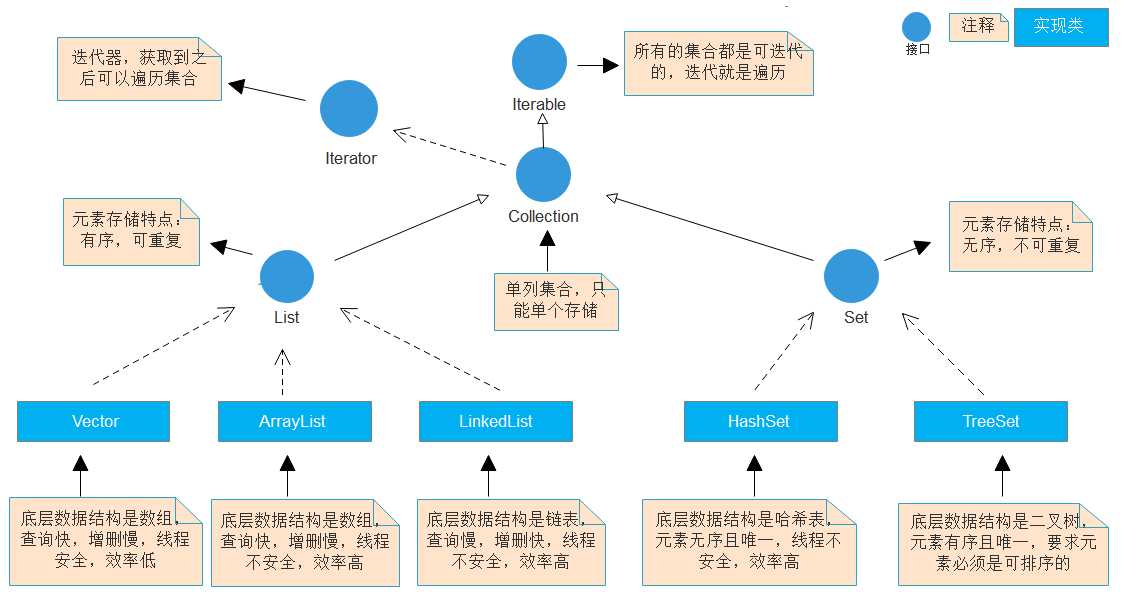
一、Collection常用方法
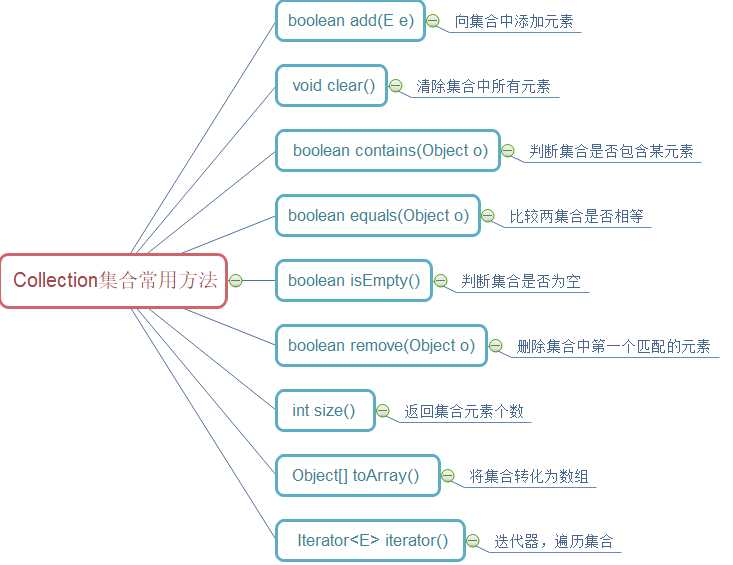
二、不同集合的使用场景
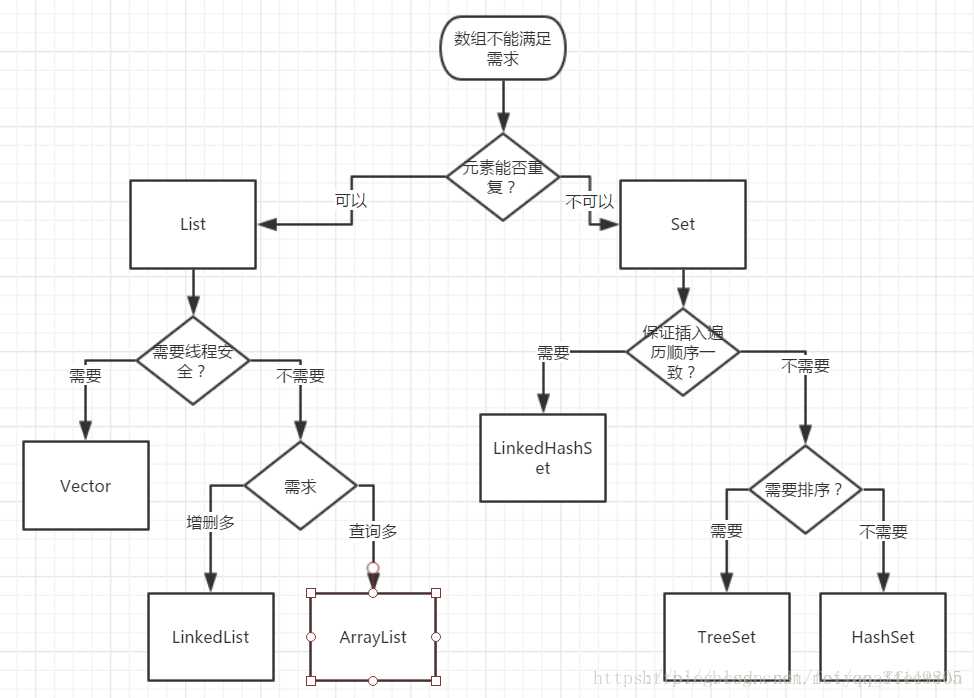

import java.util.ArrayList; import java.util.Iterator; import java.util.List; /** * 创建学生类 */ class Student { // 学号 private Integer id; // 姓名 private String name; public Student(Integer id, String name) { this.id = id; this.name = name; } @Override public String toString() { return "Student [id=" + id + ", name=" + name + "]"; } } public class TestCollection { public static void main(String[] args) { // 1. 创建集合存储String类型数据 List<String> list = new ArrayList<String>(); // 2.向集合中添加元素 list.add("猪猪侠"); list.add("超人强"); list.add("波比"); list.add("小菲菲"); // 3. 遍历集合 // 3.1普通for循环 String[] strArray = new String[list.size()]; list.toArray(strArray); // 将集合转换为数组 for (int i = 0; i < strArray.length; i++) { System.out.println(strArray[i]); } // 3.2 foreach循环 for (String str : list) { System.out.println(str); } // 3.3 迭代器遍历 Iterator<String> iterator = list.iterator(); while (iterator.hasNext()) { // hasNext():判断指针后是否有下一个元素 System.out.println(iterator.next()); // next():返回指针后的元素 } // 4. 判断集合中是否包含某元素 System.out.println(list.contains("小菲菲")); // true // 5. 判断集合是否为空 System.out.println(list.isEmpty()); // false // 6. 清除集合中所有元素 list.clear(); System.out.println(list.isEmpty()); // true System.out.println("---------------------------------------------------"); // 创建集合存储对象类型数据 List<Student> list2 = new ArrayList<Student>(); // 向集合中添加对象类型数据 list2.add(new Student(1, "张三")); list2.add(new Student(2, "李四")); // foreach遍历集合 for (Student student : list2) { System.out.println(student); } // 迭代器遍历集合 Iterator<Student> iterator2 = list2.iterator(); while (iterator2.hasNext()) { Student student = iterator2.next(); System.out.println(student); } } }
三、Map集合体系
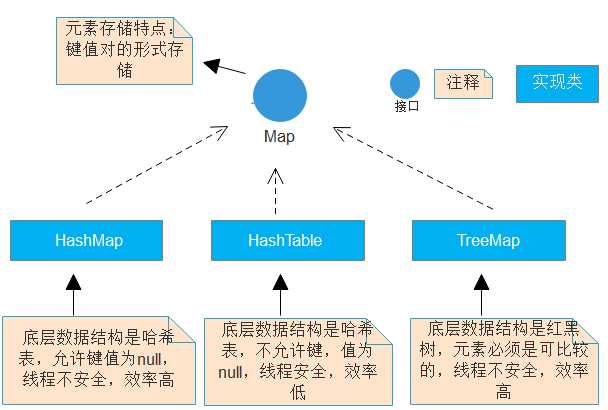
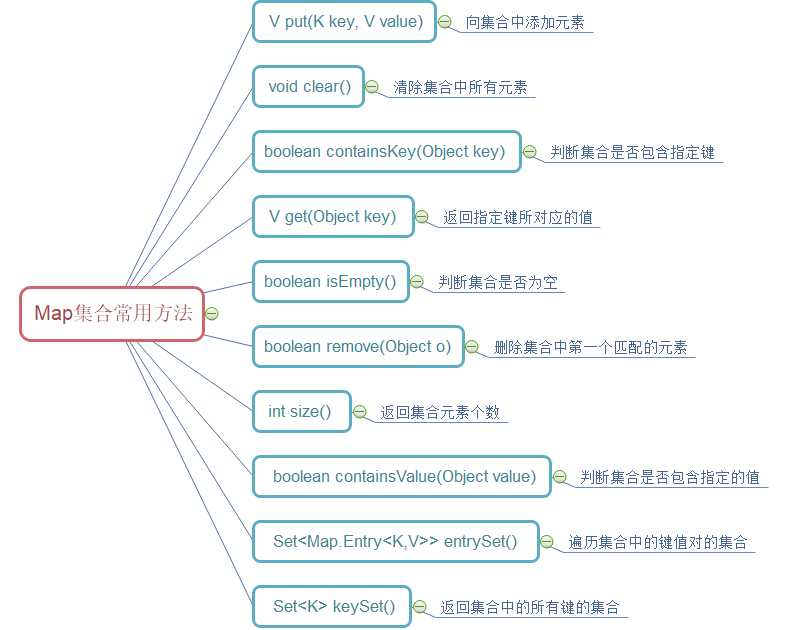

import java.util.HashMap; import java.util.Iterator; import java.util.Map; import java.util.Map.Entry; import javax.enterprise.inject.New; class Teacher { private String name; private Integer age; public Teacher(String name, Integer age) { this.name = name; this.age = age; } @Override public String toString() { return "Teacher [name=" + name + ", age=" + age + "]"; } } public class TestMap { public static void main(String[] args) { // 1. 创建Map集合存储学号和姓名 Map<Integer, String> map = new HashMap<Integer, String>(); // 2. 向map集合中添加元素 map.put(1, "张三"); map.put(2, "李四"); map.put(3, "王五"); // 3. 遍历map集合 // 3.1 通过map.keySet()遍历集合 for (Integer key : map.keySet()) { System.out.println("key=" + key + " value=" + map.get(key)); } // 3.2 通过迭代器遍历集合 Iterator<Entry<Integer, String>> iterator = map.entrySet().iterator(); while (iterator.hasNext()) { Map.Entry<Integer, String> entry = iterator.next(); System.out.println("key=" + entry.getKey() + " value=" + entry.getValue()); } // 3.3 通过map.entrySet()遍历集合 for (Entry<Integer, String> entry : map.entrySet()) { System.out.println("key=" + entry.getKey() + " value=" + entry.getValue()); } // 4. 判断集合中是否包含指定键 System.out.println(map.containsKey("1")); // true System.out.println(map.containsValue("list")); // false // 5. 判断集合是否为空 System.out.println(map.isEmpty()); // false // 6. 清除集合中所有元素 map.clear(); System.out.println(map.isEmpty()); // true System.out.println("----------------------------------------"); // 1. 创建Map集合存储对象类型数据 Map<Integer, Teacher> map2 = new HashMap<Integer, Teacher>(); // 2. 向Map集合中添加对象类型数据 map2.put(1, new Teacher("张三", 18)); map2.put(2, new Teacher("李四", 19)); map2.put(3, new Teacher("王五", 20)); // 3. 遍历集合 // 3.1 通过map.keySet()遍历 for (Integer key : map2.keySet()) { System.out.println("key=" + key + " value=" + map2.get(key)); } // 3.2 通过迭代器遍历集合 Iterator<Entry<Integer, Teacher>> iterator2 = map2.entrySet().iterator(); while (iterator2.hasNext()) { Entry<Integer, Teacher> entry = iterator2.next(); System.out.println("key=" + entry.getKey() + " value=" + entry.getValue()); } // 3.3 通过map.entrySet()遍历集合 for (Entry<Integer, Teacher> entry : map2.entrySet()) { System.out.println("key=" + entry.getKey() + " value=" + entry.getValue()); } } }
七:IO流
一、IO流简介
1. 流的概念:流是有起点和终点的一组有顺序的字节集合,作用是进行数据传输
2. 流的分类:
1. 按照数据流向不同可以分为输入输出流;
2. 按照处理数据单位不同可以分为字节流和字符流
3. 输入流和输出流的作用
1. 输入流:程序从数据源读取数据
2. 输出流:将数据从程序中写入指定文件
4. 字节流和字符流的作用
1. 字节流:以字节为单位处理所有类型数据
2. 字符流:以字符为单位处理纯文本文件
二、IO流体系
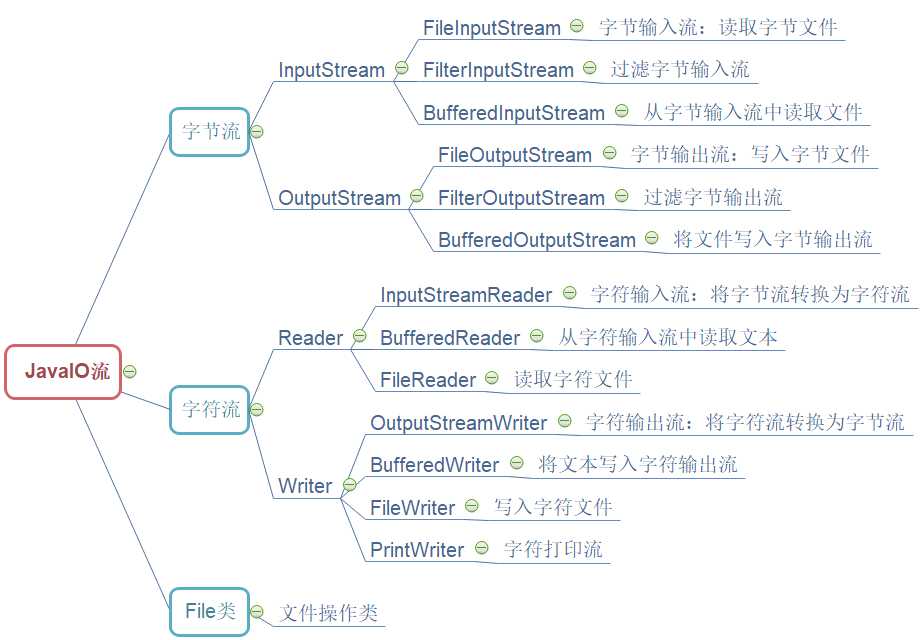
三、IO流常用方法
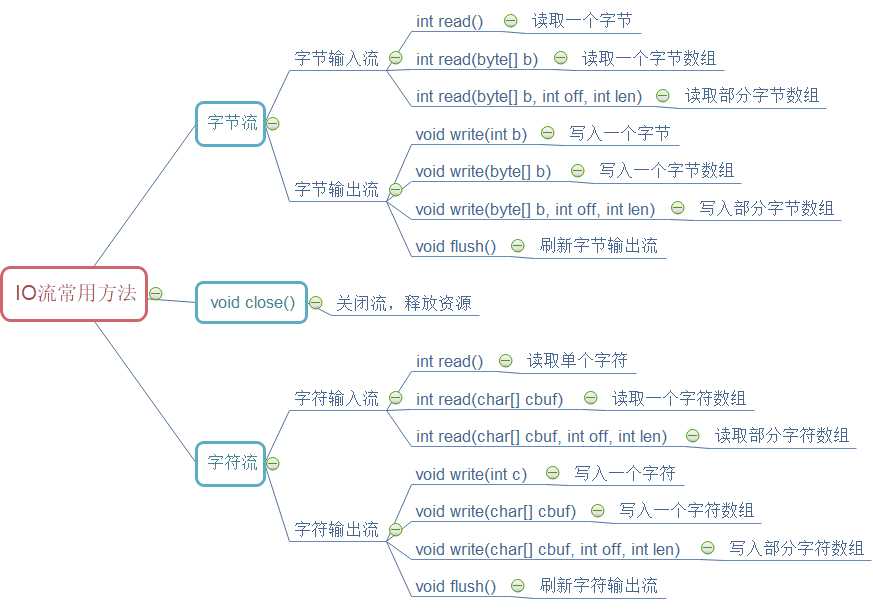

import java.io.FileInputStream; import java.io.FileNotFoundException; import java.io.FileOutputStream; import java.io.FileReader; import java.io.FileWriter; import java.io.IOException; /** * 1. 文本文件复制 * @author DELL * */ public class TestIO { public static void main(String[] args) { // 要读取的文件 String src = "E:/Workspaces1/Demo/src/TestFile.java"; // 要写入的文件 String dest = "d:/test.java"; // 1.1 一次复制一个字节 copyFile1(src, dest); // 1.2 一次复制一个字节数组 copyFile2(src, dest); // 2.1 一次复制一个字符 copyFile3(src, dest); // 2.2 一次复制一个字符数组 copyFile4(src, dest); } // 1. 一次复制一个字节,异常处理,手动关闭流 public static void copyFile1(String srcFileName, String destFileName) { FileInputStream fis = null; FileOutputStream fos = null; try { fis = new FileInputStream(srcFileName); fos = new FileOutputStream(destFileName); int cc = fis.read(); while (cc != -1) { // 一次写入一个字节 fos.write(cc); // 一次写入一个字节 cc = fis.read(); } } catch (FileNotFoundException e) { e.printStackTrace(); } catch (IOException e) { e.printStackTrace(); } finally { if (fos != null) { try { fos.close(); } catch (IOException e) { e.printStackTrace(); } } if (fis != null) { try { fis.close(); } catch (IOException e) { e.printStackTrace(); } } } } // 2. 一次复制一个字节数组,异常处理,自动关闭流 public static void copyFile2(String srcFileName, String destFileName) { // 自动关闭流 try ( FileInputStream fis = new FileInputStream(srcFileName); FileOutputStream fos = new FileOutputStream(destFileName); ) { byte[] bytes = new byte[1024]; int len = fis.read(bytes); while (len != -1) { // 一次写入一个字节数组 fos.write(bytes, 0, len); // 一次读取一个字节数组 len = fis.read(bytes); } } catch (FileNotFoundException e) { e.printStackTrace(); } catch (IOException e) { e.printStackTrace(); } } // 3. 一次复制一个字符,异常处理,自动关闭流 public static void copyFile3(String srcFileName, String destFileName) { try ( FileReader fr = new FileReader(srcFileName); FileWriter fw = new FileWriter(destFileName); ){ int cc = fr.read(); while (cc != -1) { // 一次写入一个字符 fw.write(cc); // 一次读取一个字符 cc = fr.read(); } } catch (FileNotFoundException e) { e.printStackTrace(); } catch (Exception e) { e.printStackTrace(); } } // 4. 一次复制一个字符数组,异常处理,手动关闭流 public static void copyFile4(String srcFileName, String destFileName) { FileReader fr = null; FileWriter fw = null; try { fr = new FileReader(srcFileName); fw = new FileWriter(destFileName); char[] cbuf = new char[1024]; int len = fr.read(cbuf); while (len != -1) { // 一次写入一个字符数组 fw.write(cbuf); // 一次读取一个字符数组 len = fr.read(cbuf); } } catch (FileNotFoundException e) { e.printStackTrace(); } catch (IOException e) { e.printStackTrace(); } finally { if (fw != null) { try { fw.close(); } catch (IOException e) { e.printStackTrace(); } } if (fr != null) { try { fr.close(); } catch (IOException e) { e.printStackTrace(); } } } } }

import java.io.File; import java.io.FileInputStream; import java.io.FileNotFoundException; import java.io.FileOutputStream; import java.io.IOException; import java.io.ObjectInputStream; import java.io.ObjectOutputStream; import java.io.Serializable; /** * 1. 序列化和反序列化的概念 * 1. 对象序列化:把对象转换为字节序列(二进制数据)的过程 * 2. 对象反序列化:把字节序列恢复为对象的过程 * * 2. 什么情况下需要序列化: * 1. 将对象保存到文件或数据库中时 * 2. 使用套接字在网上传送对象时 * 3. 通过RMI传输对象时 * * 3. 如何实现序列化 * 1. 创建类实现Serializable接口 * 2. 指定serialVersionUID序列号 * 3. 使用对象输出流(ObjectOutputStream)将对象保存到指定位置 * 4. 使用writerObject()方法将对象写入到文件中 * * * 4. 哪些属性不能被序列化 * 1. 使用transient修饰的属性 * 2. 使用static修饰的属性 * */ // 1. 创建类实现Serializable接口 class People implements Serializable { // 2. 指定序列号 private static final long serialVersionUID = 1L; // 静态字段 private static String id = "2019"; // transient关键字修饰的字段 private transient String name; private Integer age; public String getName() { return name; } public void setName(String name) { this.name = name; } public Integer getAge() { return age; } public void setAge(Integer age) { this.age = age; } @Override public String toString() { return "People [name=" + name + ", age=" + age + "]"; } } public class Test { public static void main(String[] args) throws FileNotFoundException, IOException, ClassNotFoundException { serializePeople(); deserializePeople(); } /** * 序列化 */ public static void serializePeople() throws FileNotFoundException, IOException { People p = new People(); p.setName("张三"); p.setAge(18); // 3. 使用对象输出流将对象保存到指定位置 ObjectOutputStream oos = new ObjectOutputStream(new FileOutputStream(new File("D:/test.txt"))); // 4. 将对象写入文件 oos.writeObject(p); System.out.println("对象序列化成功!!"); oos.close(); } /** * 反序列化 */ public static People deserializePeople() throws ClassNotFoundException, IOException { // 使用对象输入流从指定位置读取对象 ObjectInputStream ois = new ObjectInputStream(new FileInputStream(new File("D:/test.txt"))); // 读取对象 People p = (People) ois.readObject(); System.out.println("对象反序列化成功!!"); return p; } }
四、File类常用方法
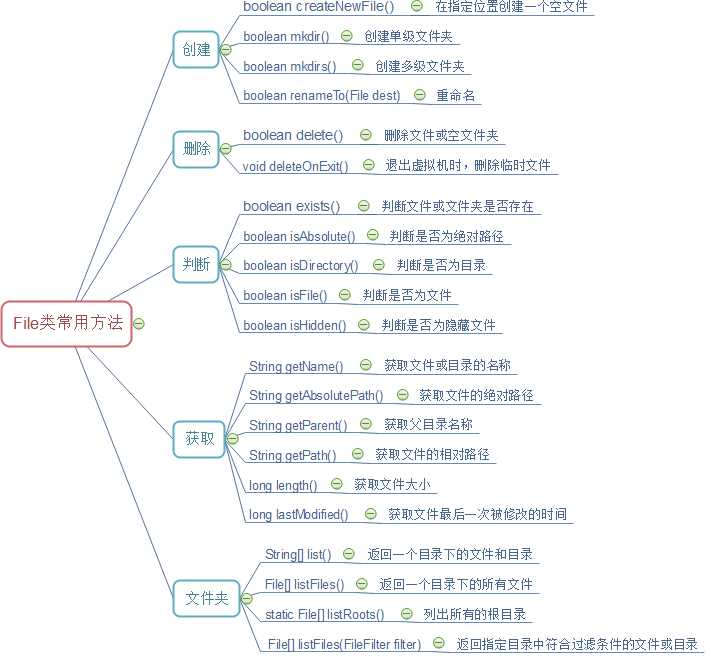

import java.io.File; import java.io.FileFilter; import java.io.IOException; import java.text.SimpleDateFormat; public class TestFile { public static void main(String[] args) throws IOException { // 1. 构造方法指明文件路径以及格式 File file = new File("D:\\test2\\test.txt"); File file2 = new File("D:\\test2"); File file3 = new File("D:\\test3"); // 2.1 创建一个文件 file.createNewFile(); // 2.2 创建一个单级目录 file2.mkdir(); // 2.3 创建一个多级目录 file3.mkdirs(); // 3.1 判断文件或文件夹是否存在 System.out.println(file.exists()); // true // 3.2 判断是否为绝对路径 System.out.println(file.isAbsolute()); // true // 3.3 判断是否为文件 System.out.println(file2.isFile()); // false // 3.4 判断是否为目录 System.out.println(file2.isDirectory()); // true // 3.5 判断是否为隐藏文件 System.out.println(file3.isHidden()); // false // 4.1 获取文件或目录名称 System.out.println(file.getName()); // 4.2 获取文件的绝对路径 System.out.println(file.getAbsolutePath()); // 4.3 获取文件相对路径 System.out.println(file.getPath()); // 4.4 获取文件父目录 System.out.println(file.getParent()); // 4.5 获取文件大小 System.out.println(file.length()); // 4.6 获取文件最后一次被修改时间 SimpleDateFormat sdf = new SimpleDateFormat("yyyy-MM-dd HH:mm:ss"); String updateTime = sdf.format(file.lastModified()); System.out.println(updateTime); // 5.1 返回此目录下的所有文件和目录 String [] fileString = file2.list(); for (String str : fileString) { System.out.println(str); } // 5.2 返回此目录下的所有文件 File [] files = file2.listFiles(); for (File file4 : files) { System.out.println(file4.getName()); } // 5.3 返回所有根目录 File [] files2 = File.listRoots(); for (File file4 : files2) { System.out.println(file4); } // 5.4 返回指定目录中符合过滤条件的文件和目录 File [] files3 = file2.listFiles(new FileFilter() { @Override public boolean accept(File pathname) { while ("a.txt".equals(pathname.getName())){ return true; } return false; } }); for (File file4 : files3) { System.out.println(file4.getName()); } } }
八:多线程
一、线程相关概念
1. 线程和进程
1. 进程:操作系统中的应用程序,一个进程就是一个应用程序
2. 线程:CPU调度的最小单元,进程的一个执行流
2. 上下文切换
1. 上下文切换:CPU从一个线程或进程切换到另一个进程或线程;
2. 多线程程序并不是同时进行的,由于CPU的执行速度太快,CPU会在不同的线程之间快速的切换执行;
二、多线程的三种实现方式及优缺点

import java.util.concurrent.Callable; import java.util.concurrent.FutureTask; /** * 1. 创建多线程的三种方式 * 1. 继承Thread类 * * 2. 实现Runnable接口 * 1. 方式一:创建类实现Runnable接口 * 1. 创建类实现Runnable接口 * 2. 重写run()方法 * 3. 使用Thread类的构造方法实例化实现Runnable接口的类对象 * 4. 开启线程 * * 2. 方式二:使用匿名内部类 * 1. 使用Thread类的构造方法创建一个Runnable接口的代理对象 * 2. 重写run()方法 * 2. 开启线程 * * 3. 实现Callable接口 * 1. 方式一:创建类实现Callable接口 * 1. 创建类实现Callable接口 * 2. 重写call()方法 * 3. 使用Thread类的构造方法实例化FutureTask对象 * 4. 使用FutureTask类的构造方法实例化实现了Callable接口的类对象 * 5. 开启线程 * * 2. 方式二:使用匿名内部类 * 1. 使用Thread类的构造方法实例化FutureTask对象 * 2. 使用FutureTask类的构造方法创建Callable接口的代理对象 * 3. 重写call()方法 * 4. 开启线程 * * 2. 三种方式的优缺点 * 1. 继承了Thread类 * 1. 优点:代码书写简单 * 2. 缺点:由于Java的单继承性,代码的耦合度比较高 * * 2. 实现了Runnable接口和Callable接口 * 1. 方式一: * 1. 优点:代码的可扩展性更强 * 2. 缺点:没有缺点 * * 2. 方式二: * 1. 优点:代码书写简单 * 2. 缺点:只适合线程使用一次的时候 */ /** * 1. 继承Thread类 */ class Thread1 extends Thread{ public static void test() { for (int i = 0; i < 100; i++) { System.out.println("继承Thread类执行的第" + i + "次"); } } } /** * 2. 实现Runnable接口 */ class Thread2 implements Runnable{ @Override public void run() { for (int i = 0; i < 100; i++) { System.out.println("实现Runnable接口方式一执行的第" + i + "次"); } } } /** * 3. 实现Callable接口 */ class Thread3 implements Callable<Integer>{ @Override public Integer call() throws Exception { int i = 0; for (; i < 100; i++) { System.out.println("实现Callable接口方式一执行的第" + i + "次"); } return i; } } public class TestThread { public static void main(String[] args) { // 1. 测试继承Thread类 Thread1 thread1 = new Thread1(); thread1.start(); Thread1.test(); // 2. 测试实现Runnable接口 // 2.1 方式一 new Thread(new Thread2()).start(); // 2.2 方式二 new Thread(new Runnable() { @Override public void run() { for (int i = 0; i < 100; i++) { System.out.println("实现Runnable接口方式一执行的第" + i + "次"); } } }).start(); // 3. 测试实现Callable接口 // 3.1 方式一 new Thread(new FutureTask<Integer>(new Thread3() { }), "方式三").start();; // 3.2 方式二 new Thread(new FutureTask<Integer>(new Callable<Integer>() { @Override public Integer call() throws Exception { int i = 0; for (; i < 100; i++) { System.out.println("实现Runnable接口方式二执行的第" + i + "次"); } return i; } })).start();; } }
三、多线程常用方法
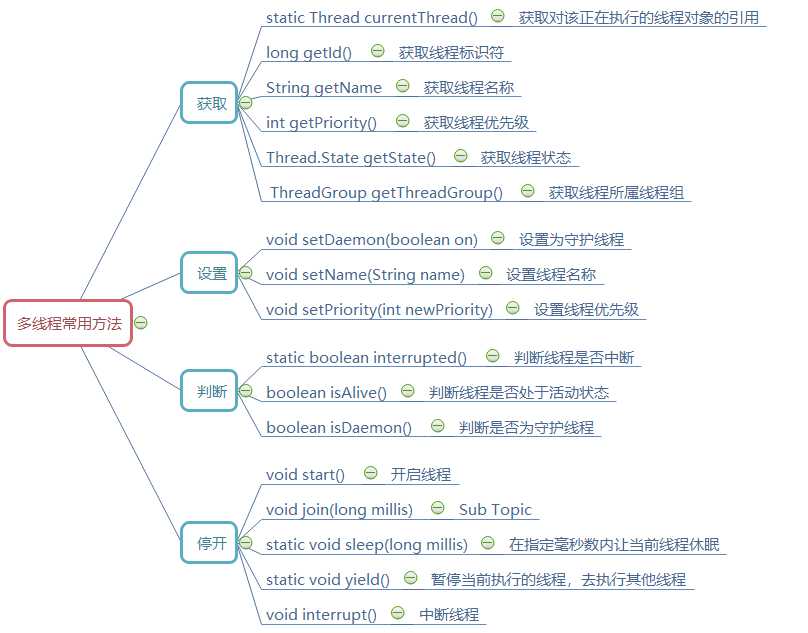

public class TestThreadMethod { public static void main(String[] args) { Thread thread = new Thread(new Runnable() { @Override public void run() { for (int i = 0; i < 100; i++) { // 获取正在执行的线程对象的引用 System.out.println(Thread.currentThread().getName() + "执行的第" + i + "次"); } } }); // 1. 开启线程 thread.start(); // 2. 设置 // 2.1 设置该线程名称 thread.setName("线程1号"); // 2.2 设置该线程为守护线程:main方法结束之后该线程停止 //thread.setDaemon(true); // 2.3 设置该线程的优先级 thread.setPriority(7); // 3. 获取 // 3.1 获取线程名称 System.out.println(thread.getName()); // 线程1号 // 3.2 获取线程标识符 System.out.println(thread.getId()); // 13 // 3.3 获取线程优先级 System.out.println(thread.getPriority()); // 7 // 3.4 获取线程状态 System.out.println(thread.getState()); // RUNNABLE // 3.5 获取线程所在线程组 System.out.println(thread.getThreadGroup()); // java.lang.ThreadGroup[name=main,maxpri=10] // 4. 判断 // 4.1 判断线程是否中断 System.out.println(thread.isInterrupted()); // false // 4.2 判断线程是否为活动状态 System.out.println(thread.isAlive()); // true // 4.3 判断线程是否为守护线程 System.out.println(thread.isDaemon()); // false // 5. 停 // 5.1 让线程休眠指定毫秒数 new Thread(new Runnable() { @Override public void run() { for (int i = 0; i < 50; i++) { System.out.println(Thread.currentThread().getName() + "执行的第" + i + "次"); if (i == 25) { try { /** * 1. sleep()是静态方法 * 2. sleep()使用时必须捕获异常 * 3. sleep()执行时,只是让该线程进入阻塞状态,并不会释放锁 */ System.out.println("线程2号正在休眠"); Thread.sleep(5000); } catch (InterruptedException e) { e.printStackTrace(); } } } } },"线程2号").start(); // 5.2 暂停当前线程去执行其他线程 new Thread(new Runnable() { @Override public void run() { for (int i = 0; i < 50; i++) { System.out.println(Thread.currentThread().getName() + "执行了" + i + "次"); if (i == 25) { /** * 1. yield()是静态方法 * 2. yield()执行时,让线程进入就绪状态,重新争抢CPU执行权,并不会释放锁 */ Thread.yield(); } } } },"线程3号").start(); // 5.3 等待线程销毁 new Thread(new Runnable() { @Override public void run() { for (int i = 0; i < 100; i++) { if (i == 50) { /** * 1. join()是对象方法 * 2. join()使用时必须捕获异常 * 3. join()使用场景:一个执行完的线程需要另一个正在执行的线程的运行结果时 */ System.out.println("线程1号正在销毁!!!!"); try { thread.join(); } catch (InterruptedException e) { e.printStackTrace(); } System.out.println("线程1号销毁成功!!!!"); } } } },"线程4号").start(); } }
四、线程同步
5.网络编程
6.反射
标签:number his nim strong pwd emma list() transient art
原文地址:https://www.cnblogs.com/mh20131118/p/11070787.html